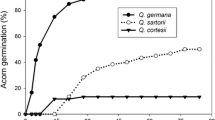Abstract
The Asian evergreen broad-leaved forests in Southwestern China are among the most diverse in the world. Quercus schottkyana is a dominant oak in these forests but its seedlings are noticeably uncommon. Quercus schottkyana has desiccation-sensitive acorns despite being widespread in regions with a distinct 5- to 6-month dry season shortly following acorn drop. Here we investigated the effects of desiccation and post-dispersal predation by rodents and bark beetles [Coccotrypes sp. (Coleoptera: Curculionidae)] on acorns of Q. schottkyana. Most acorns of Q. schottkyana lie on the soil surface after dispersal, but some acorns (1.5 %) were buried. For the sound acorns (acorns not infested by weevils) that lay on the soil surface during the dry season, moisture content decreased to 34.6 % in the cotyledons and 42.3 % in the axes and viability decreased significantly from 81 to 32 %. Surface acorns were also subject to high infestation by bark beetles which emerge towards the end of the dry season and cause high mortality of acorns that survived the dry season. Burial effectively retained moisture and viability of acorns during the dry season. However, approximately 75 % of buried sound acorns were subsequently damaged by bark beetles. We show that desiccation and post-dispersal infestation by Coccotrypes sp. killed about 98 % of sound acorns on the soil surface before germination could begin in June but about 20 % of buried sound acorns germinated. However, because most acorns of Q. schottkyana lie on the soil surface and there is limited burial, regeneration of this species from acorns is problematic.




Similar content being viewed by others
References
Borchert MI, Davis FW, Michaelsen J, Oyler LD (1989) Interactions of factors affecting seedling recruitment of blue oak (Quercus Douglasii) in California. Ecology 70:389–404
Boucher DH, Sork VL (1979) Early drop of nuts in response to insect infestation. Oikos 33:440–443
Climatic Data Center, National Meteorological Information Center (CMA) (2015) China Meteorological Data Sharing Service System. http://cdc.nmic.cn/home.do. Accessed 2015
Crawley MJ (2013) Seed predators and plant population dynamics. In: Galagher RS (ed) Seeds: the ecology of regeneration in plant communities, 3rd edn. CAB International, Oxford, pp 94–110
Fuchs MA, Krannitz PG, Harestad AS (2000) Factors affecting emergence and first-year survival of seedlings of Garry oaks (Quercus garryana) in British Columbia. Can For Ecol Manage 137:209–219
Germaine HL, McPherson GR (1998) Effects of timing of precipitation and acorn harvest date on emergence of Quercus emoryi. J Veg Sci 9:157–160
Gómez JM, García D, Zamora R (2003) Impact of vertebrate acorn- and seedling-predators on a Mediterranean Quercus pyrenaica forest. For Ecol Manage 180:125–134
Gómez JM, Puerta-Piñero C, Schupp EW (2008) Effectiveness of rodents as local seed dispersers of Holm oaks. Oecologia 155:529–537
Huang CJ, Zhang YT, Bartholomew B (1999) Fagaceae. In: Wu ZY, Raven PH (eds) Flora of China, vol 4. Science Press, Beijing, pp 314–400
ISTA International Rules for Seed Testing (2007) International Seed Testing Association, Bassersdorf
Janzen DH (1971) Seed predation by animals. Ann Rev Ecol Syst 2:465–492
Jordal BH, Normark BB, Farrell BD, Kirkendall LR (2002) Extraordinary haplotype diversity in haplodiploid inbreeders: phylogenetics and evolution of the bark beetle genus Coccotrypes. Mol Phylogenet Evol 23:171–188
Li Q, Ma K (2003) Factors affecting establishment of Quercus liaotungensis koidz. Under mature mixed oak forest overstory and in shrubland. For Ecol Manage 176:133–146
Li HJ, Zhang ZB (2003) Effect of rodents on acorn dispersal and survival of the Liaodong oak (Quercus liaotungensis, Koidz.). For Ecol Manage 176:387–396
Liu K, Eastwood RJ, Flynn S, Turner RM, Stuppy WH (2008) Seed Information Database (release 7.1) http://www.kew.org/data/sid
Lombardo JA, McCarthy BC (2008) Silvicultural treatment effects on oak seed production and predation by acorn weevils in southeastern Ohio. For Ecol Manag 255:2566–2576
Lorimer CG, Chapman JW, Lambert WD (1994) Tall understory vegetation as a factor in the poor development of oak seedlings beneath mature stands. J Ecol 82:227–237
Maeto K, Ozaka K (2003) Prolonged diapauses of specialist seed-feeders makes predator satiation unstable in masting of Quercus crispula. Oecologia 137:392–398
Marquis DA, Eckert PL, Roach BA (1976) Acorn weevils, rodents, and deer all contribute to oak-regeneration difficulties in Pennsylvania. U.S.D.A. Forest Service Research Paper NE-356
Peng J, Ding S-Y (1992) Study on upground biomass of Cyclobalanopsis glaucoides sprouted shrub community in the central part of Yunnan plateau. J Yunnan Univ 14:191–197 (in Chinese with English abstract)
Perea R, López D, Miguel AS, Gil L (2012) Incorporating insect infestation into rodent seed dispersal: better if the larva is still inside. Oecologia 170:723–733
Pritchard HW (2004) Classification of seed storage ‘types’ for ex situ conservation in relation to temperature and moisture. In: Guerrant EO, Havens K, Maunder M (eds) Ex situ plant conservation: supporting species survival in the wild. Island Press, Washington, pp 139–161
R Development Core Team, R (3.2.0): a language and environment for statistical computing. (2015) Available at: https://www.r-project.org/ (Accessed: 2015)
Roberts EH (1973) Predicting the storage life of seed. Seed Sci Technol 1:499–514
Shaw MW (1968) Factors affecting the natural regeneration of sessile oak (Quercus Petraea) in North Wales: II. acorn losses and germination under field conditions. J Ecol 56:647–660
Sork VL (1984) Examination of seed dispersal and survival in red oak, Quercus rubra (Fagaceae), using metal-tagged acorns. Ecology 65:1020–1022
Sork VL (1993) Evolutionary ecology of mast-fruiting in temperate and tropical oaks (Quercus spp.). Vegetatio 107(108):133–147
Steele MA, Hazeltine J (1996) Caching and feeding decisions by Sciurus carolinensis: responses to weevil-infested acorns. J Mamma 77:305–314
Su W-H, Zhang G-F (2002) Dynamics of the seed bank of Cyclobalanopsis glaucoides in Cyclobalanopsis glaucoides forest on the Xishan Mountain in Kunming. Acta Bot Yunn 24:289–294 (in Chinese with English abstract)
Sun S, Gao X, Chen L (2004) High acorn predation prevents the regeneration of Quercus liaotungensis in the Dongling mountain region of North China. Restor Ecol 12:335–342
Vander Wall SB (2001) The evolutionary ecology of nut dispersal. Bot Rev 67:74–117
Wang CY, Zhu F, Zhang Z-Y, He Z-R, Li X-S, Ou G-L, Xiang L (2014) Parasitism in acorns of Cyclobalanopsis glaucoides and Castanopsis delavayi (Fagaceae) and its impact on population regeneration. Plant Div Res 36:629–638 (in Chinese with English abstract)
Wood SL (1982) The bark and ambrosia beetles of North and Central America (Coleoptera: Scolytidae), a taxonomic monograph. Gt Basin Nat Mem 6:1–1359
Wood SL, Bright DA (1992) A catalog of Scolytidae and Platypodidae (Coleoptera) Part 2: taxonomic index Gt. Basin Nat Mem 13:1–1553
Xia K, Daws MI, Hay FR, Chen W-Y, Zhou Z-K, Pritchard HW (2012a) A comparative study of desiccation responses of seeds of Asian evergreen oaks, Quercus subgenus Cyclobalanopsis and Quercus subgenus Quercus. S Afr J Bot 78:47–54
Xia K, Daws MI, Stuppy W, Zhou Z-K, Pritchard HW (2012b) Rates of water loss and uptake in recalcitrant fruits of Quercus species are determined by pericarp anatomy. PLoS One 7:e47368. doi:10.1371/journal.pone.0047368
Xia K, Hill LM, Li D-Z, Walters C (2014) Factors affecting stress tolerance in recalcitrant embryonic axes from seeds of four Quercus (Fagaceae) species native to the USA or China. Ann Bot 114:1747–1759
Yu F, Shi X, Wang D et al (2015) Effects of insect infestation on Quercus aliena, var. Acuteserrata, acorn dispersal in the Qinling Mountains. China New For 46:51–61
Acknowledgments
This work was supported by the National Natural Science Foundation of China (NSFC) (No. 31200318) to KX and NSFC- Yunnan joint fund to support key projects (Nos. U1502231 and U1302262). We thank You Li and Jiri Hulcr for identifying the bark beetle specimens, Lian-yi Li for photographing the bark beetle and Li Wang and Qian Hu for their assistances in the field. We thank Wei-bang Sun for giving us the permission to work in the study site and two anonymous reviewers whose comments significantly improved this manuscript.
Author information
Authors and Affiliations
Corresponding author
Additional information
Communicated by Prof. Lauchlan Fraser, Dr. Chris Lortie and Dr. JC Cahill.
Rights and permissions
About this article
Cite this article
Xia, K., Tan, HY., Turkington, R. et al. Desiccation and post-dispersal infestation of acorns of Quercus schottkyana, a dominant evergreen oak in SW China. Plant Ecol 217, 1369–1378 (2016). https://doi.org/10.1007/s11258-016-0654-1
Received:
Accepted:
Published:
Issue Date:
DOI: https://doi.org/10.1007/s11258-016-0654-1




